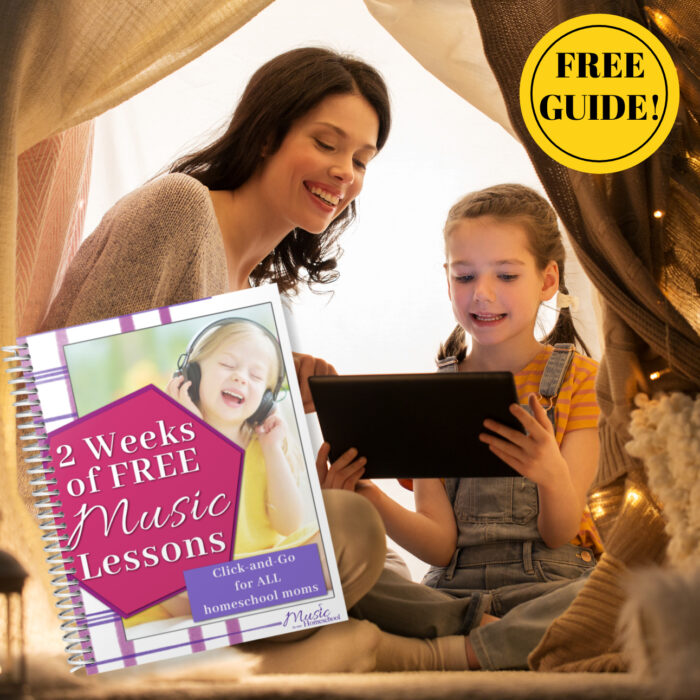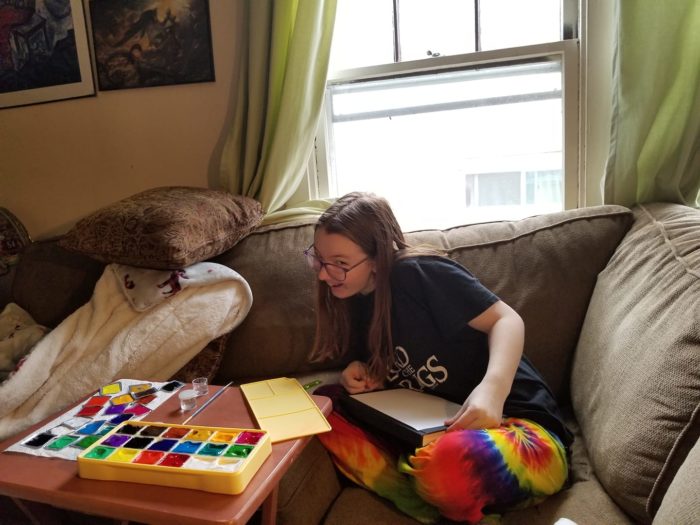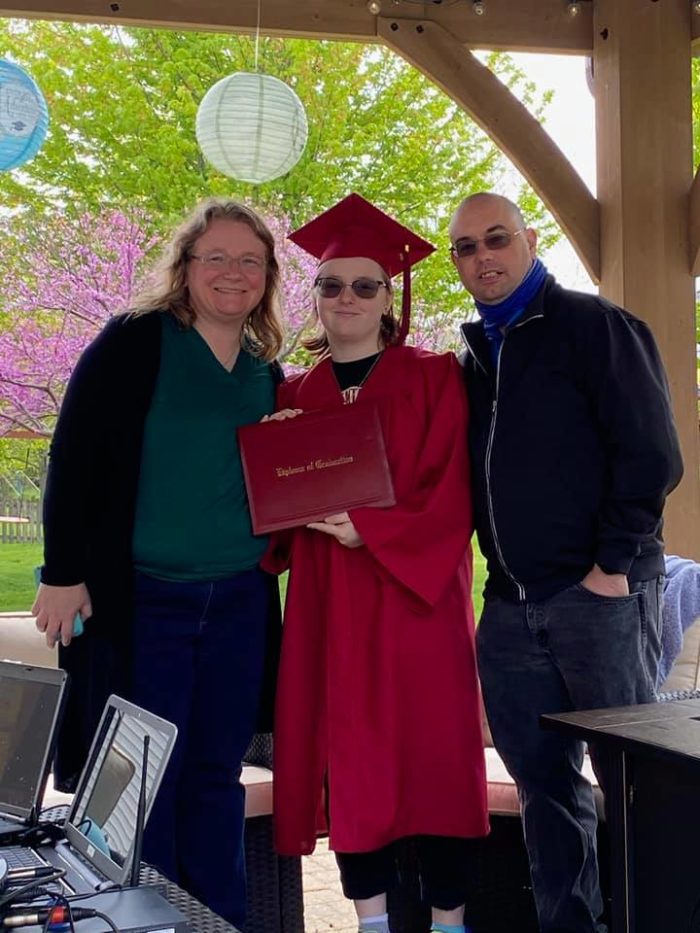Unique Ways to Homeschool a Creative Teen in High School
[“How to Homeschool a Creative Teen in High School” is a guest post from contributor Michelle Habrych]

Disclosure: I get commissions for purchases made through affiliate links in this post.
Follow the Lead of the Creative Teen
One of the benefits of homeschooling for any age is the ability you have to follow the lead of the child, to make sure she is understanding what is being taught before moving on to the next lesson, to follow rabbit trails into areas of interest, and to have learning time whenever works best for your student.
All too often though, when students reach high school age, the homeschool mom worries she is not equipped to handle higher level classes, navigate dual enrollment possibilities, or fit in all of the necessary items to properly graduate her student. Add to this, whether from peers or self imposed, the pressure to take advantage of all the extra curricular possibilities and opportunities to earn college credits while in high school. When your student does not fit that scholarly, advanced, graduate-with-an-associate’s-degree model, the pressure can be overwhelming to feel as if you are somehow failing your student by not pushing him to pursue every CLEP credit and community service experience.
No “Right Way” to Homeschool High School
I have graduated two students from my homeschool and I have felt that described pressure. I have also reminded myself again and again that there is no “right way” to homeschool high school. My children had very different learning styles and aspirations, and I discovered it was best to release the expectations and assist them each to have their best high school experience.
Best Tips for Homeschooling a Creative Teen:
My daughter is a creative soul. She has always loved art, beginning when she could first hold a pencil or crayon, continuing through lessons about Monet and Warhol, and leading to her first semester at an art college to pursue a degree in video game design. I knew there were times I should push her to complete certain subjects as well as times I had to let go of the prescribed “college prep” course of study to allow her the freedom to be the artist God designed her to be.
The following are my best tips for homeschooling a creative teen, which may be adapted for any sort of creative bent.
Set expectations but be flexible.
My husband and I had planned that our kids would have certain required courses of study to graduate from our homeschool. Our state has very relaxed standards, so meeting them was not a concern. However, where we desired our kids to study Spanish, this truly was not a priority for either of them. It would have been frustrating to push them through simply because it was our idea of what they should do. Does this mean that if my student does not want to take a certain subject that I drop it? Absolutely not! However, it became apparent that my daughter who struggled with spelling in English would not succeed in another language unless it was something she wanted to pursue. She was not motivated, so we changed course.
She chose to study American Sign Language; however, the class she was registered to take at our homeschool co-op was canceled due to the pandemic in 2020. She did watch some videos on her own and used an ASL dictionary to self-teach, but not enough to learn much. Thankfully, foreign language was not a prerequisite for her school of choice, so the matter was dropped.
Stick to the basics.
Math is not my daughter’s strong suit. Much to her annoyance, she struggles with numbers. She was never able to memorize her facts when everyone else was doing it, which meant math took many times longer than it needed to. Eventually we permitted a calculator, yet she still struggled to memorize which operation to do when reading a word problem. Nothing helped it to “click” for her. As a result, since I knew she would not be pursuing higher education which required specific math courses, we permitted her to push through the basics. Pre-algebra, algebra, geometry, and personal finance were her high school math credits. The only concern had been SAT/ACT; how would she score without higher math?
Find a dream and pursue it.
I never thought my girl, who really disliked anything resembling school such as writing papers, studying for a test, completing math problems, would attend a four-year college. I figured she would simply work her way through basic academics at the community college, supplementing with art classes there, or perhaps she would find an art school. When she told me she desired college, I became concerned. College meant admission essays, standardized test scores, and multiple years of foreign language classes and science labs– or so I thought. Once she decided pursuing college was her priority, I took her to a college fair at our community college. It was there we discovered the existence of some non-traditional colleges. She put herself on the mailing lists and perused colorful brochures of high-tech art colleges.
She started to dream. I offered to take her to visit the campus she was most interested in learning more about, even though it was six hours and two states away from home. We went and she fell in love. I committed to her that I would do all I could on my side to help her achieve the dream of studying at that school. One bonus for us was the unbelievable truth that the school’s admission process differed vastly from traditional colleges. The school removed the standardized test as a requirement. Her course load did not matter either. The main requirements for admission at this all-art college were to graduate high school and show your artwork portfolio. They were looking for talent with potential. The rest was a bonus. In the fall of 2020, my daughter applied to only that one school and was accepted. She has now completed her first year there. She pursued her dream and I supported it.
Supporting the dream.
What does supporting the dream look like? For me, it was allowing her the freedom to only take the classes necessary for graduation in our state and then permitting her to choose the electives. It meant giving her time and space to create. Here are some of her high school electives: Art I, Art 2, Intro to Mixed Media, Independent Art Study, Choir, and Music Appreciation. We are part of a homeschool co-op where these types of classes were offered, but think of other ways to include them (community theater productions, online courses, community college classes, and church worship team are a few ideas). As for the required courses, I allowed her to help guide the subject matter when possible.
For science, she took Biology (at homeschool co-op), Earth Science and Astronomy (at home with her brother and two other students), History of Science with Physics (a cross-curricular course with history and literature which I created for her to complete on her own based off the Guest Hollow math-free physics curriculum, and STEM Electronics (at homeschool co-op).
For social studies, she completed Cuisine and Culture (a world history look at food at homeschool co-op), American History (which I taught her combined with American Literature at homeschool co-op), Economics (with a couple of other families), and Government (at homeschool co-op).
Instead of spending time preparing for the SAT or ACT, she worked on her art. She was given a positive review of her portfolio on National Portfolio Day, propelling her even closer to achieving her dream.
Allow her to work at her own pace.
My daughter is not a morning person. On days when she did not have to be somewhere at a certain time, I permitted her to set her own schedule and to complete her work as she desired, within reason.
Learn from the world around you.
We visited many art museums prior to 2020. And, we spent another year learning and experiencing through field trips. Visiting lovely places to take photographs or sketch is life-giving for the creative student. Listening to music or seeing a live performance buoys her spirits like nothing else. Allow time for these things.
When possible, give credit for the time spent. For example, my daughter took a once-a-week music appreciation course virtually with our homeschool group during the pandemic. To supplement and make enough course material for a high school fine arts credit, we watched countless musicals, including many on this list.
Find opportunities away from you to build her skills.
During the summer before her junior year, my daughter attended a Christian arts camp at a local college, put on by Masterpiece Ministries. For a week she focused on being creative. I assumed she would have chosen the visual arts portion of the camp, but she surprised me by taking creative writing. During that week, she was able to learn from a published author and see first-hand what it was like to combine faith and creative gifts.
The pandemic provided opportunities to attend online creative camps as well. Search the internet to see what is available when you’re ready to pursue this option; I highly recommend it.
One place she would not have traveled to but which offered a very reasonably priced online workshop was Max the Mutt College of Animation, Art, and Design in Toronto. Another was College for Creative Studies in Michigan. I don’t know if these places currently offer online workshops, but it’s worth checking out for your creative student to build confidence and help develop her portfolio.
Don’t compare.
It’s easy to fall into the comparison trap, both for you as the mom or for her as the student. Your friend’s daughter graduated both high school and earned an associate’s degree at the same time due to dual enrollment. Congratulations to her on that achievement! Another friend’s son is earning CLEP credits at home while completing high school. Good for him! Only you and your student know what will work for your particular situation.
I knew my daughter would not perform well if I pressured her to do either of those tracts of learning. So I allowed her to be a kid while she was still a kid. If she had asked me to try one of those options, I would have given her the tools to succeed. However, knowing your child’s unique aptitudes will save a lot of tears of frustration.
Final Thoughts About How to Homeschool a Creative Teen
Allowing your child to be creative and learn at her own pace is the best way to homeschool a creative teen in high school. Avoid a one-size-fits-all method of education; after all, that is one reason many of us homeschool!
Michelle Habrych is a retired homeschool mom, having graduated her two students in 2019 and 2021. She continues to teach at the homeschool co-op they were part of for 16 years. She enjoys reading, writing, and teaching.
Related Homeschool High School Posts:
- My Best Tips for Homeschooling High School ~ From My Own Experience!
- Online Courses in Your Homeschool
- How to Prepare for Your Senior Year of Homeschool High School
- How to Successfully Plan a Homeschool Graduation Ceremony and Party
Other Related Posts Written by Michelle:
- How to Host a Big Messy Art Camp: Summer Camp Series
- How to Provide Opportunities in the Arts for Homeschoolers
- How to Teach a High School English Survey Class at a Homeschool Co-op
- How to do a Mother-Daughter American Girl Book Club
- A Step-by-Step Guide to Planning Next Year’s Homeschool (with Free Printable)













